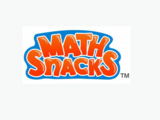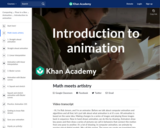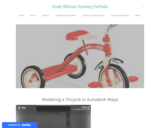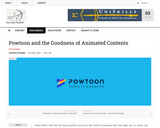
Pamela explains how to use loops to iterate through each value in an array.
- Subject:
- Applied Science
- Computer Science
- Material Type:
- Interactive
- Lesson
- Provider:
- Khan Academy
- Provider Set:
- Khan Academy
- Author:
- Pamela Fox
- Date Added:
- 07/11/2021

Pamela explains how to use loops to iterate through each value in an array.

Pamela shows how to program animations, using the draw() function.

We'll explain how to draw circles with code (JavaScript and ProcessingJS), and then you'll get to try it yourself in a challenge.

Math Snacks is a fun and interactive educational series. This website contains five animated videos focusing on key mathematical concepts included in the Common Core curriculum for grades 4-8. Each interactive is beautifully illustrated, contains audio, and is supported by supplementary printable resources. All learner resources are available in both English and Spanish. Teacher guides as well as teaching videos support classroom implementation. A powerful supplementary tool for educators teaching about ratios, rates, scale factor, unit conversion, and the number line, as well as a source for children's educational entertainment at home.
Math Snacks was developed by the Learning Games Lab located at New Mexico State University.

The role that math plays in computer animation.

Video lectures modeling a tricycle in Autodesk maya using polygon and NURBS tools.

Pamela shows how to modify an array while your code is running, to add or change values.

Pamela shows how to modify objects while your program is running, to change existing properties or add new ones.

Pamela explains how to use mouseIsPressed with if statements to execute code only when the user is pressing their mouse.

Sophia shows how to use a while loop to draw multiple shapes in a row.

Jessica Liu explains more important things you should know about using variables.

Pamela explains how to use mouseX and mouseY to make cool interactive programs.

Pamela explains how to use nested for loops for more complex repeating code.

The Shiny@UCLouvain platform is a repository for sharing teaching resources created in Shiny for the Catholic University of Louvain (UCLouvain) with the aim of teaching statistics with interactive apps. The list of apps (Inference, Probability, Distributions, Central Limit Theorem, Confidence intervals, Hypothesis test on the mean, Bootstrap confidence intervals, Design of Experiments , ...) associated with the RShiny@UCLouvain platform can be found at https://sites.uclouvain.be/RShiny/main.html . The source code of the apps can be found at https://forge.uclouvain.be/rshiny_uclouvain .

Pamela shows how objects can inherit and re-use the code of other object types.

Pamela shows how to attach methods to object types, that you can call on any instance of that object.

Pamela explains the first part of object-oriented programming: creating object types and instances of those object types.

This new online version of the Educational CPU Visual Simulator allows users to visualize with detailed animations the execution of assembly language code. Its main goal is to support novices in understanding the behavior of the key components of a CPU, focusing on how code written in high-level languages is actually executed on the hardware of a computer.
It supports a simplified but representative assembly language of 16 (Data Transfer, Control Flow, Arithmetic-Logic) instructions, with immediate and direct addressing modalities. Instructions and numeric data can be inserted and edited directly in RAM. It is possible to define “labels” to be used as parameters in jump instructions, or as variable identifiers. The speed and level of detail of the animations can be controlled by the users. At any time, it is possible to switch between symbolic and binary representations.
It was successfully evaluated in Colorado: Cortinovis, R., & Rajan, R. Evaluating and improving the Educational CPU Visual Simulator: a sustainable Open Pedagogy approach, Proceedings of the 33rd Annual Workshop of the Psychology of Programming Interest Group (PPIG).
More information available in: Cortinovis, R. (2021). An educational CPU Visual Simulator, Proceedings of the 32nd Annual Workshop of the Psychology of Programming Interest Group (PPIG).

Pamela explains "pseudo-code", a way to plan out your program before you code it.

This blog post is a thanksgiving to Powtoon for their pleasant gesture of supporting the act of teaching. I wrote to them that their free account limitations are hampering the way we need to help the students stuck at home. Citing the Coronavirus and the subsequent lockdown, I asked for an increase in the time limit of videos we can make on their free account.
Helen Keller said that the most pathetic person in the world is someone who has sight, but no vision. Our visions prompt us to see the beauty and uniqueness of things around. We also want to make things that move swiftly through the eyes of the viewers to their heart and make an appreciated mark on their intellects.
The animation is the key and the lock as well in this case. We lock our creativity and content in small Powtoon work and let it reach the learners. They use the same key and open it to unleash an abundance of interesting screening on the devices.